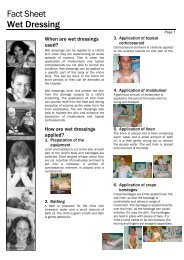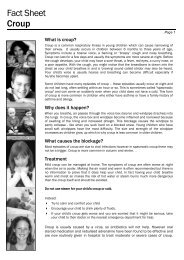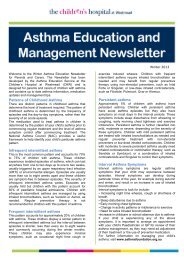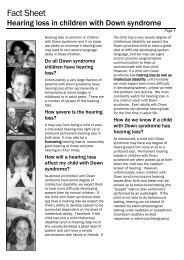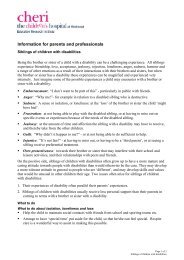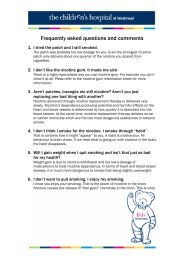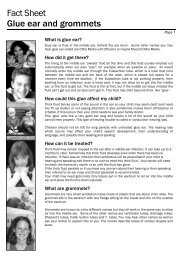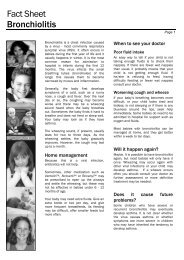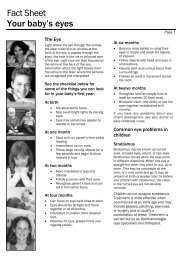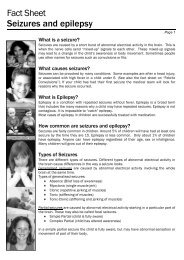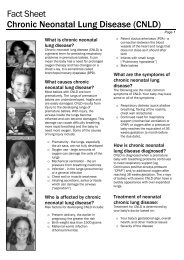Fact Sheet Children's Pain The Facts - Kids Health @ CHW
Fact Sheet Children's Pain The Facts - Kids Health @ CHW
Fact Sheet Children's Pain The Facts - Kids Health @ CHW
You also want an ePaper? Increase the reach of your titles
YUMPU automatically turns print PDFs into web optimized ePapers that Google loves.
<strong>Fact</strong> <strong>Sheet</strong><br />
<strong>Children's</strong> <strong>Pain</strong> – <strong>The</strong> <strong>Fact</strong>s<br />
xcvxcvxcv<br />
Very young children or children who<br />
are very sick cannot always tell us<br />
exactly what they are feeling. This can<br />
be quite distressing for parents who<br />
may feel confused about what their<br />
child is experiencing. Parents know<br />
their child’s usual reactions and<br />
behaviours.<br />
What is pain?<br />
Many things affect a child’s<br />
experience of pain:-<br />
<strong>The</strong>ir age.<br />
<strong>The</strong>ir beliefs and understanding of<br />
what is causing the pain.<br />
<strong>The</strong>ir beliefs in their own ability to<br />
cope.<br />
<strong>The</strong>ir previous pain experiences<br />
and how they have seen other<br />
people dealing with pain.<br />
How they have learned to respond<br />
to pain.<br />
How long does pain last?<br />
Acute pain<br />
<strong>The</strong> term “acute pain” refers to pain<br />
that is not long-lasting. <strong>The</strong> pain may<br />
be caused by an operation, injury,<br />
illness, or medical procedure.<br />
Depending on what has caused the<br />
pain, the pain may last a few seconds<br />
(eg. a needle) through to a few weeks<br />
or months (eg. following an injury).<br />
Some pain from an operation is<br />
normal and is a part of the whole<br />
healing process. Acute pain can be<br />
helped with medications, which can<br />
be given by various methods. You can<br />
also help your child with acute pain<br />
by using non-drug methods such as<br />
relaxation and distraction techniques.<br />
Chronic pain<br />
Chronic pain lasts for a longer period<br />
of time, usually longer than 3-6<br />
Page 1<br />
months. This pain can be constant or<br />
come and go at different times. It is<br />
sometimes difficult to find a cause for<br />
chronic pain. However there are<br />
treatments and special programs that<br />
can help your child cope better with<br />
chronic pain.<br />
How do you know your<br />
child is in pain?<br />
It is not always easy to know how<br />
much pain your child is experiencing,<br />
listening to what they say and<br />
watching what they do can help us.<br />
Things that can show that your child<br />
is in pain include:-<br />
Crying.<br />
Facial changes or pulling a face.<br />
Changes in their sleeping or<br />
eating patterns.<br />
Becoming quiet and withdrawn.<br />
Screaming.<br />
Refusing to move.<br />
Some children may tell us they are<br />
sore or hurting but may find it difficult<br />
to say how much they are hurting.<br />
Remember that changes in their<br />
behaviour can also occur because<br />
they are scared or frightened.<br />
Children can use a scale such as the<br />
Faces <strong>Pain</strong> Scale - Revised below.<br />
This will involve asking your child to<br />
point to the face that shows how<br />
much hurt they are feeling from “no<br />
pain” on the left through to “very<br />
much pain” on the right.
<strong>Fact</strong> <strong>Sheet</strong><br />
<strong>Children's</strong> <strong>Pain</strong> – <strong>The</strong> <strong>Fact</strong>s<br />
xcvxcvxcv<br />
Faces <strong>Pain</strong> Scale - Revised. ©2001 IASP.<br />
www.painsourcebook.ca<br />
Hicks CL, von Baeyer CL, Spafford P, van<br />
Korlaar I, Goodenough (2001)<br />
Remember<br />
Parents are often the best judges<br />
of their child's pain.<br />
Listen to what they tell you and<br />
watch what they do.<br />
If worried or in doubt about your<br />
child's pain, talk to your local<br />
doctor or if you are in hospital, a<br />
nurse or doctor.<br />
If you are unsure of whether or<br />
not to give any medication for<br />
your child's pain, it is best to get<br />
advice from your doctor or<br />
pharmacist.<br />
More information on helping children<br />
cope with painful procedures is available<br />
from the following web-site:<br />
http://pediatricpain.ca/content/Families<br />
This fact sheet is for education purposes only.<br />
Please consult with your doctor or other health professional<br />
to make sure this information is right for your child. This document was reviewed on 11 th<br />
June 2010.<br />
www.chw.edu.au www.sch.edu.au www.kaleidoscope.org.au<br />
Page 2<br />
© <strong>The</strong> Children’s Hospital at Westmead, Sydney Children’s Hospital, Randwick & Kaleidoscope * Hunter Children’s <strong>Health</strong> Network 2005 – 2011



